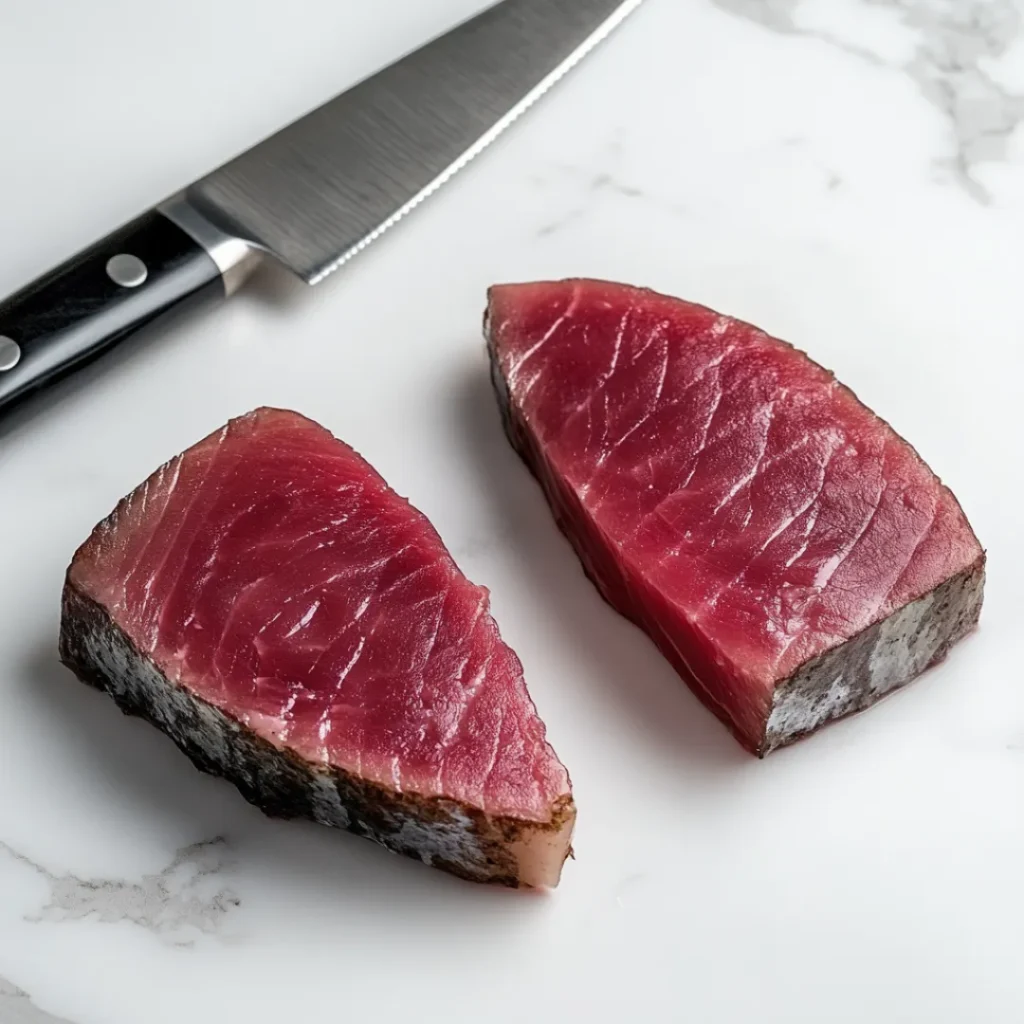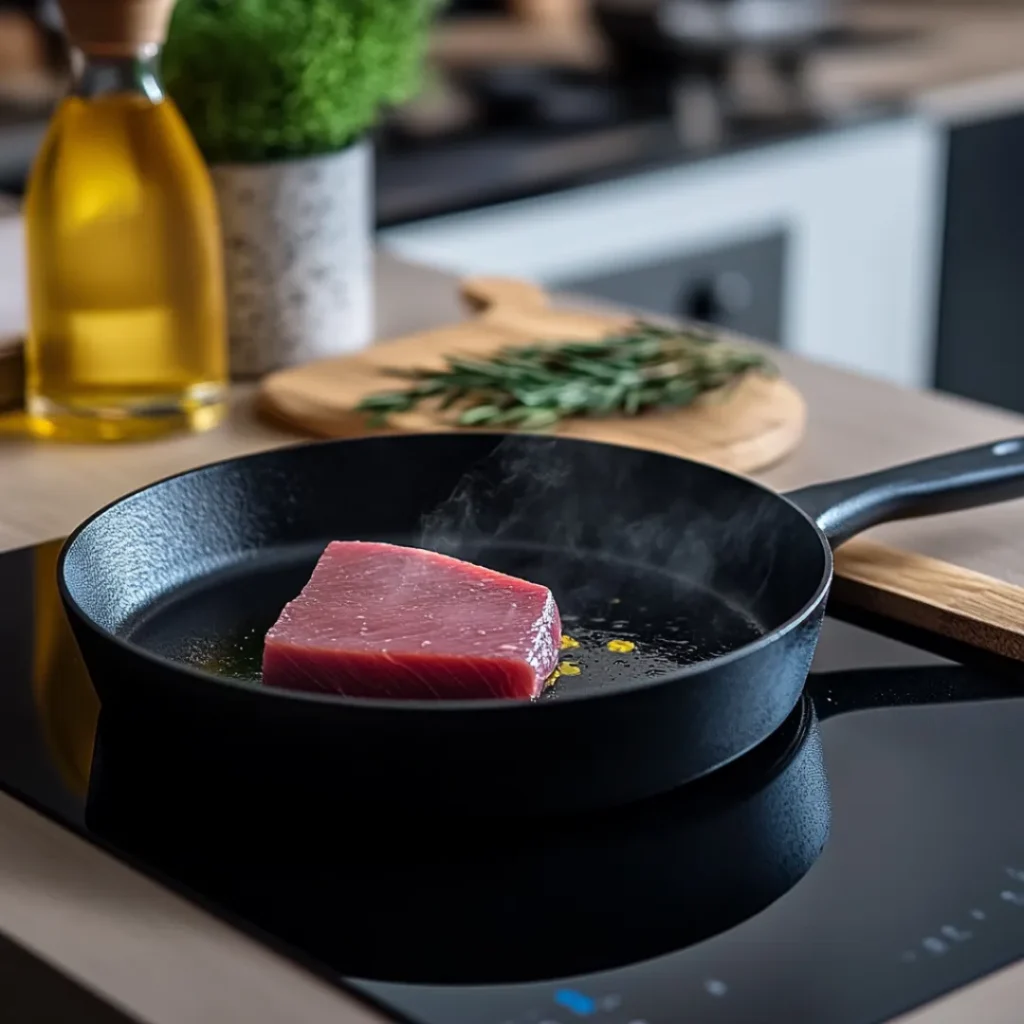How Long Does It Take to Sear Ahi Tuna? A Comprehensive Guide
Let’s face it—there’s something magical about a perfectly seared ahi tuna steak. That crispy, golden crust on the outside paired with that melt-in-your-mouth rare center? Honestly, it’s like a flavor party in your mouth! But here’s the deal: getting it just right can feel kinda tricky if you’re new to cooking fish. You might be wondering, how long does it take to sear ahi tuna? Well, don’t sweat it—by the end of this article, you’ll have all the answers (and tips!) you need to nail it every single time.
We’re gonna break it down step by step, from understanding what makes ahi tuna so special to mastering the art of searing it just right. Plus, we’ll sprinkle in some pro tips and answer those burning questions you didn’t even know you had. So grab your apron, and let’s get started!
Table of Contents
Introduction to Searing Ahi Tuna
Why Searing Ahi Tuna Matters
You know how they say first impressions matter? Well, when it comes to ahi tuna, the way you cook it makes all the difference. Searing is hands down one of the best ways to bring out its natural flavors while keeping that tender texture intact. Unlike grilling or baking, searing gives you that crave-worthy crust without overcooking the inside. And honestly, who doesn’t love a good contrast between crispy and soft?
But here’s the kicker—it’s not just about tossing it in a pan and hoping for the best. The question everyone asks is, how long does it take to sear ahi tuna? Spoiler alert: it’s quicker than you think. We’re talking mere minutes per side, depending on how done you like it. But don’t rush off just yet! There are a few things you’ll wanna keep in mind before diving in.
Key Factors Influencing Searing Time
When it comes to searing ahi tuna, timing isn’t everything—but it’s close. Things like the thickness of your steak, the heat of your pan, and how “done” you want it all play a role. For instance, thinner cuts will cook faster, while thicker ones need a bit more love. Oh, and don’t forget about your stove type! Gas stoves tend to heat up quicker than electric ones, which can affect your overall searing time.
So yeah, there’s a bit of science to it—but don’t worry, we’ll walk you through it all. By the time you finish reading, you’ll know exactly how long to sear ahi tuna and why it matters so much. Stay tuned!
Part 2: Understanding Ahi Tuna (300 words)

What Is Ahi Tuna?
Alright, let’s back up for a sec—what exactly is ahi tuna? Well, it’s just a fancy name for yellowfin tuna, a type of fish that’s super popular in seafood dishes. You’ve probably seen it on menus at sushi spots or high-end restaurants, right? It’s prized for its rich flavor and firm texture, which makes it perfect for searing. Honestly, if you’re looking to impress your dinner guests (or yourself!), ahi tuna is the way to go.
But here’s the thing—you can’t just grab any old piece of fish and expect greatness. That’s why knowing what to look for is key. And once you’ve got the good stuff, you’ll want to know how long does it take to sear ahi tuna? Spoiler: it’s fast, but we’ll get into that later. For now, let’s focus on what makes this fish so special.
Characteristics of High-Quality Ahi Tuna
So, how do you spot top-notch ahi tuna? First off, check the color—it should be a bright, vibrant red, not dull or brownish. If it smells “fishy,” that’s a red flag. Fresh ahi tuna has a mild, ocean-like scent, not something that knocks you over. The texture matters too; it should feel firm to the touch, not mushy or slimy.
Here’s a pro tip: if you’re buying frozen ahi tuna, make sure it’s been flash-frozen. This locks in freshness and keeps the quality intact. But honestly, fresh is always better if you can swing it. Once you’ve got your hands on some primo tuna, you’ll be ready to tackle the big question: how long does it take to sear ahi tuna?
Why Sear Ahi Tuna?
Now, you might be wondering, why sear it instead of grilling or baking? Great question! Searing gives you that perfect balance of a crispy exterior and a tender, rare center. Plus, it’s quick—like, really quick. We’re talking minutes, not hours. If you’re short on time but still want something impressive, searing ahi tuna is your best bet.
Thickness of the Tuna Steak
Let’s talk about thickness because, honestly, it’s a game-changer. Most chefs recommend using ahi tuna steaks that are about 1 to 1.5 inches thick. Why? Because thinner cuts cook faster and can easily overcook, leaving you with something more like canned tuna than the gourmet dish you were aiming for. On the flip side, thicker cuts need a bit more time to develop that golden crust without overdoing the inside.
If you’re working with thinner steaks, you’ll want to reduce the searing time. So, when someone asks, how long does it take to sear ahi tuna?, the answer depends a lot on the thickness. Keep that in mind before you toss it in the pan!
Stove Type and Pan Material

Next up, let’s chat about your stove and pan. Here’s the deal: not all stoves are created equal. Gas stoves heat up faster and give you more control, while electric ones can take a bit longer to reach the high temps needed for searing. As for pans, cast iron is a fan favorite because it holds heat like a champ, giving you that even sear. Stainless steel works too, but nonstick pans? Not so much—they don’t get hot enough for that crispy crust.
Oh, and one more thing—if your pan isn’t screaming hot before you add the tuna, you’re setting yourself up for disappointment. So crank that heat and give it a few minutes to preheat. Trust me, it’s worth it.
Desired Doneness
Now, here’s where things get personal—how done do you like your tuna? Some folks love it rare, with just a quick sear on each side (about 30 seconds). Others prefer medium-rare, which takes around 1–2 minutes per side. If you’re into medium, you’re looking at closer to 3–4 minutes per side.
But here’s the kicker: how long does it take to sear ahi tuna? depends a lot on your preference. Just remember, overcooking is the fastest way to ruin this delicate fish. Keep an eye on it, and don’t be afraid to check the inside before serving.
Room Temperature vs. Cold Tuna
Finally, let’s talk about temperature. Pulling your tuna out of the fridge 20–30 minutes before cooking can make a huge difference. Why? Because room-temp tuna cooks more evenly. Cold tuna straight from the fridge can lead to uneven searing, where the outside burns before the inside gets a chance to warm up.
So, if you’re aiming for perfection, give your tuna a little time to chill (literally and figuratively) before tossing it in the pan.
FAQs About Searing Ahi Tuna
How long should you sear ahi tuna on each side?
Alright, let’s cut to the chase—this is the most common question people ask. The answer depends on how you like your tuna. If you’re going for rare, sear it for about 30 seconds per side. For medium-rare, aim for 1–2 minutes per side. And if you’re into medium, go for 3–4 minutes per side. But here’s the deal: no matter your preference, keep an eye on it. Overcooking can turn that beautiful ahi tuna into something dry and chewy. So, when in doubt, remember this: how long does it take to sear ahi tuna? It’s quick, so don’t walk away!
Can you sear frozen ahi tuna?
Good question! While fresh tuna is always ideal, frozen works too—if it’s been flash-frozen. Here’s the trick: thaw it completely before cooking. Trying to sear frozen tuna straight from the freezer will leave you with uneven results. Plus, it’ll mess with your timing. So, plan ahead and let it thaw in the fridge overnight. Once it’s ready, you can follow the same steps as you would with fresh tuna. Easy peasy!
What’s the best oil for searing ahi tuna?
When it comes to oil, not all are created equal. You’ll want something with a high smoke point, like avocado oil or sesame oil. Why? Because searing requires high heat, and oils with low smoke points (like olive oil) can burn and ruin the flavor. Sesame oil, in particular, adds a nice nutty kick that pairs perfectly with ahi tuna. Just don’t overdo it—a little goes a long way.
How to tell when ahi tuna is perfectly seared?
Here’s a pro tip: use your instincts—and maybe a fork. Perfectly seared tuna should have a crispy crust on the outside but still be soft and pinkish-red in the center. If you’re unsure, make a tiny cut to check the inside. Remember, it’s better to undercook slightly since the residual heat will keep cooking it as it rests.
Part 7: Conclusion (100 words)
So there you have it—everything you need to know about how long does it take to sear ahi tuna? From understanding the factors that affect cooking time to nailing the perfect doneness, you’re officially ready to tackle this dish like a pro. Honestly, once you get the hang of it, searing ahi tuna is a breeze. It’s quick, healthy, and oh-so-delicious. Whether you’re whipping up a weeknight dinner or impressing guests, this dish is sure to shine.
And hey, don’t stress if it’s not perfect the first time—practice makes progress! So grab some fresh ahi tuna, crank up the heat, and give it a shot. Your taste buds will thank you.
Part 8: Common Mistakes to Avoid When Searing Ahi Tuna (300 words)
Overcooking the Tuna
Let’s get real for a second—overcooking is the cardinal sin when it comes to searing ahi tuna. You know how we’ve been talking about how long does it take to sear ahi tuna? Well, here’s why timing matters so much. Overcooked tuna turns dry, chalky, and honestly, kinda sad. The goal is to keep that center juicy and pinkish-red, not gray and tough. So, resist the urge to leave it on the pan “just a little longer.” Trust the clock, and remember: less is more when it comes to this delicate fish.
Incorrect Pan Temperature
Here’s another biggie—if your pan isn’t hot enough, you’re setting yourself up for failure. A lukewarm pan won’t give you that golden crust you’re aiming for. Instead, you’ll end up with steamed tuna, which is… not great. On the flip side, if the pan’s too hot, you risk burning the outside before the inside cooks. So, how do you know if it’s ready? Throw a drop of water into the pan—if it sizzles and evaporates instantly, you’re good to go.
Skipping Resting Time
You might be tempted to dig in as soon as the tuna hits the plate, but hold your horses! Skipping the resting time is a rookie mistake. Letting the tuna rest for 3–5 minutes after searing allows the juices to redistribute, keeping it moist and flavorful. Think of it like letting a steak rest—it’s a small step that makes a huge difference.

